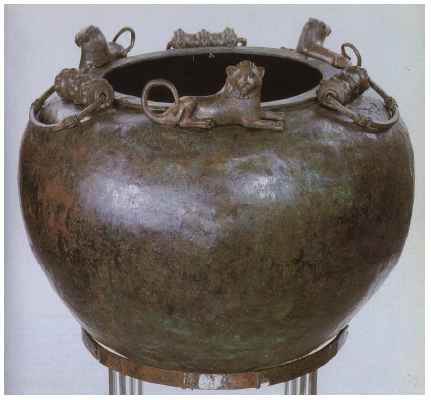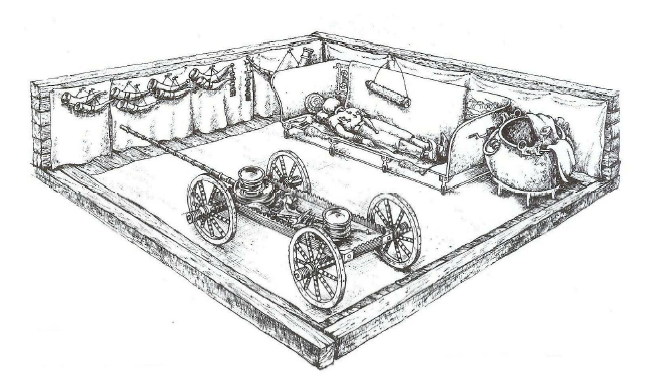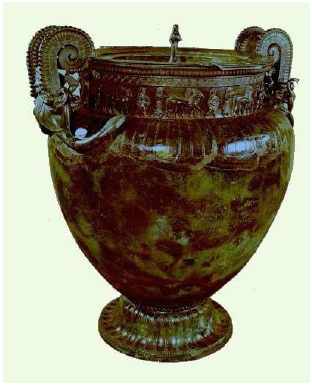C) The Cauldron of Hochdorf and the Cauldron of the Dagda
The use of sacred mead on the occasion of religious rites in Celtic times is confirmed by some archaeological discoveries, the most significant one being the 500-litre cauldron, discovered in 1978 in the sumptuous burial place of a Celtic prince, dated c. 550-500 BC, in Hochdorf (Baden Württemberg), Germany (fig. 15).
The cauldron, of Greek manufacture, was situated in the Prince’s funeral chamber, next to the bed, and rested on a specially-made wooden support (fig. 16). A gold cup, which originally lay on a piece of embroidered cloth, the remains of which were preserved on the brim of the cauldron, was discovered at the bottom of the cauldron. The Prince’s funerary furniture also included nine drinking horns (eight small ones made of aurochs and a 5.5-litre iron drinking horn), which were hung on the wall next to the funerary bed.2375 The richly decorated elements of this drinking set are indicative of a carefully-prepared religious rite in relation to drinking.


Botanical analysis, carried out by Dr. Haas of the Botanical Institute of Hohenheim, revealed that the residue was very rich in pollen grains which had been the components of a particular honey. This analysis proved that the cauldron did not contain southern wine but a liquid based on a maceration of honey and water, that is mead.2376 The gold cup was almost certainly used for drawing the liquid from the cauldron to fill in the drinking horns. The pollinic analysis revealed that the mead originally contained in the Cauldron of Hochdorf was composed of a relatively large amount of honey (between 73 and 292 kg), which meant that this mead was strong and of high quality. The honey used in the preparation of the beverage came from a surprising number of varieties of plants, growing in quite diverse terrains and areas. It was indeed a complex composition of thyme, jasmine of the mountains, plantains, centaurea jacea, anthyllis vulneraria, carex (acid herbs), ranunculus lingua, meadowsweet, succisa, several types of campanulas, sweet peas, papilionaceous plants, vetches, etc.2377 It is interesting to note that 98-99% of pollen grains come from herbaceous plants, while only 1-2% belong to tree essence. This means that the honey of Hochdorf was a summer flower honey and was not a simple honey, but an elaborate and very rich composition of different types of honeys, gathered from numerous bee colonies - given that a wild colony can produce up to 10kg of honey per year - situated in various areas on account of the impressive variety of flowers. The complexity of the preparation of the Hochdorf mead and its large quantity prove that we are in the presence of an intoxicating beverage of a sacred nature.
Furthermore, this discovery proves that mead was used on the occasion of religious and funerary rites. We have seen through the previous pages that intoxication was an ancestral custom specifically practiced in various religious contexts with the intention of reaching the divine. Here the drinking of mead must have aimed at making contact with the divine so as to assure the deceased a safe travel to the otherworld. The composition of the drinking set - the enormous size of the cauldron and the nine drinking horns - attests to the sharing of mead in the context of a religious ceremony. The intoxicating rite must have been accompanied with prayers and songs to honour the dead and be heard by the deities. The priests (druids), intermediary of the deities on earth, were in charge of the preparation and course of the funerary rites. After carefully preparing the complex intoxicating beverage and consuming it, they must have gone into a trance, invoked the gods and prayed for the deceased to be accepted in the otherworld. In drinking the divine beverage, the priest would have symbolically ingested the deity itself, for mead, and its ensnaring powers, is personified by goddesses bearing its name. The goddesses of mead-intoxication must have consequently symbolized the cult of consuming intoxicating beverages on special occasions which required the presence of the divine, as well as its series of rituals.
According to Jörg Biel, the drinking set of Hochdorf is quite unusual for a Hallstatt funerary room, as regards the number of drinking horns and the cup in gold, which is quite rare. The singular number of drinking horns, and their size and location in the funerary room, is nevertheless highly significant, for it reinforces the idea of sacredness. It is noteworthy that the number of drinking horns (nine) was a ‘magical’ number possessing a ritual and sacral value in ancient times. The number nine is indeed the square of three, which was the Celtic magical number par excellence, emblem of the divine force (see Chapter 1). Nine therefore induces completeness and omnipotence of the divine powers.2378 Moreover, it is worth noticing that, being the last of the series of figures, it evokes the end of a cycle, both an end and a new beginning. In other words, it denotes the ideas of death and rebirth, which perfectly suits the death of a Prince who would rise from his ashes in the otherworld. The number of drinking horns, as part of a religious funerary rite in honour of the dead, is thus revealing and not insignificant. Moreover, the biggest horn, the content of which is atypical (5.5. litres), was probably destined for the dead Prince, for it was hung right above his head in the funerary room. He would have therefore been included in the rite of mead-intoxication.
The Cauldron of Hochdorf can be related to the enormous bronze crater*, holding 1,100 litres, discovered in 1953 in a female’s tomb, dating from around 480 BC, in Vix (Côte d’Or), which could have also contained mead or some local sacred beverage (fig. 17).2379 One cannot help thinking that these huge cauldrons, containing intoxicating drinks ensuring contact with the divine and immortality, brilliantly echo the mythical huge cauldron of the Irish Dagda, the father god of the Tuatha Dé Danann. The main attribute of the ‘Good God’ was indeed a great inexhaustible cauldron (coiri an Dagdai) from which “no company ever went away unsatisfied”, as described in Cath Maige Tuired [‘The Second Battle of Mag Tuired’].2380 The cauldron is the Celtic symbol of feasting par excellence. The text does not specify what the cauldron of the Dagda contained: was it food or was it drink?2381 The archaeological discoveries in Gaul and Germany, such as Vix and Hochdorf, tend to prove that the cauldron was not necessarily a kitchen utensil as is generally believed, but rather a piece of crockery specifically used in religious and ceremonial contexts, containing offerings to the gods, such as animal or vegetal offerings, or intoxicating drinks which were served and shared in the context of peculiar ceremonies or rites aiming at making contact with the divine world.2382 The Dagda’s cauldron of plenty and immortality is therefore the mythical reflection of ancient Celtic religious rituals, which are evidenced by archaeological discoveries, such as the Cauldron of Hochdorf.
